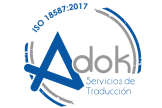Transcription
Transcription refers to the process of converting audio or video content into a written format either in verbal or non-verbal language. This method provides added value to many companies along with the subtitling of videos and audios for the development of advertising, commercial and marketing content.
It is not possible to use any computer programme capable of transcribing correctly as it is a type of artisanal work that cannot be automated due to several factors, such as subject matter, accents, punctuation and context, must be taken into account.
Although nowadays human translation and transcription are still essential to maintain quality standards, technology makes it easier and faster to carry out transcription work, so the combination of the two is ideal to achieve a quality service in record time.
What do I need transcriptions and translations for?
Transcription and translation services are often used in different fields and scenarios.
![]() Commercial and advertising videos. In the world we currently live in, companies must know how to adapt to their target audience and that is why more and more companies are transcribing commercial and advertising videos to expand their business into an international market, increase sales and grow their positioning.
Commercial and advertising videos. In the world we currently live in, companies must know how to adapt to their target audience and that is why more and more companies are transcribing commercial and advertising videos to expand their business into an international market, increase sales and grow their positioning.
![]() Speeches and conferences. There are many high-impact international conferences and lectures where audio transcription services are a key element to document the event and, if necessary, translate it into the respective language.
Speeches and conferences. There are many high-impact international conferences and lectures where audio transcription services are a key element to document the event and, if necessary, translate it into the respective language.
![]() Judicial acts. In legal proceedings, the audio or video of the event is usually recorded to be able to analyse what happened afterwards. Due to this, it is often necessary to transcribe what happened in order to have everything documented.
Judicial acts. In legal proceedings, the audio or video of the event is usually recorded to be able to analyse what happened afterwards. Due to this, it is often necessary to transcribe what happened in order to have everything documented.
![]() Dubbing. The transcription of the script of audio or video files in any language is necessary for dubbing.
Dubbing. The transcription of the script of audio or video files in any language is necessary for dubbing.
What types of transcriptions are there??
![]() Verbatim transcriptions
Verbatim transcriptions
A verbatim transcription is a transcription that accurately captures the words and sounds of the audio or video. It includes both mumbles, mistakes, unfinished words, sounds and others.
For example, “Yesterday I was, uh…, at home, although…, well, I was only there for 20 minutes while I was getting ready”.
This type of verbatim transcription is used in court proceedings, investigations or medical analysis where any details given may be relevant to the case.
![]() Natural transcriptions
Natural transcriptions
Natural transcriptions are the most commonly used technique as they consist of eliminating all irrelevant information, such as stammering, interjections, interjections and others, resulting in a clearer and more professional text.
For example, the following sentence transcribed literally, “Well… eh…, well eh…, I don’t remember well, what I saw was eh… a man in a shop” would naturally be transcribed as follows, “Well, I don’t remember well, what I saw was a man in a shop”.
As can be seen, in a natural transcription, the syntactic order and agreement are recomposed and corrected, thus improving the coherence and cohesion of the speech to make it easier to understand.
What is the price of a transcription?
The price of a transcription depends on several factors:
– Length of the video or audio
– Number of speakers appearing
– Quality of the recording
– Source language
– Type of transcript selected
– Delivery time
Each project has its own particular characteristics, so it is best for you to send us the files and we can then give you a quote tailored to your needs.
Transcripts are delivered in editable Word format and you also have the option to select the correctly structured SRT format to use for subtitles.
All videos and audios are transcribed by our team of professional translators with extensive experience in transcription, selected on the basis of native speakers of the source language of the content to achieve excellence.
No matter the language of the audio or video, our professional team is made up of qualified translators with extensive experience in various language combinations.
Clinter holds the following European ISO quality certifications: UNE-EN ISO 9001:2015, UNE-EN ISO 17100:2015 (specific to translations) and UNE-EN ISO 18587:2020 (specific to translations in the machine and post-edition translation variant), being the second company in Spain to obtain this last one.










